
Written in 2022 by Kaoru
 For the longest time, Dragon Quest was the best-selling game franchise in Japan and is still one of the three main money making pillars for Square Enix next to Final Fantasy and Kingdom Hearts. Regularly selling millions of copies ever since Dragon Quest III hit stores in 1988. People even skipped work and school to get their hands on it as soon as possible so that Enix decided to only ever release future main entries on holidays.
For the longest time, Dragon Quest was the best-selling game franchise in Japan and is still one of the three main money making pillars for Square Enix next to Final Fantasy and Kingdom Hearts. Regularly selling millions of copies ever since Dragon Quest III hit stores in 1988. People even skipped work and school to get their hands on it as soon as possible so that Enix decided to only ever release future main entries on holidays.
The idea came producer Yuji Horii during a convention showing off Wizardry and Ultima, deciding to try his hand on a similar game but for a console. He got hot new manga artist Akira Toriyama to do the designs and prolific composer and shit person Koichi Sugiyama to contribute the beeps and boops. The three of them stayed with those roles on every main game for 30 years up to and including Dragon Quest XI. Thus the franchise is known for being very traditional, the quintessential standard JRPG experience. Mostly because it is the one that defined said standards. At least initially, today’s quicker playing JRPGs with complex narratives aren’t actually that close to the way Dragon Quest does things anymore.
After many years of not doing too well or not releasing at all in the West, one can nowadays get almost all of the games on several platforms in English.
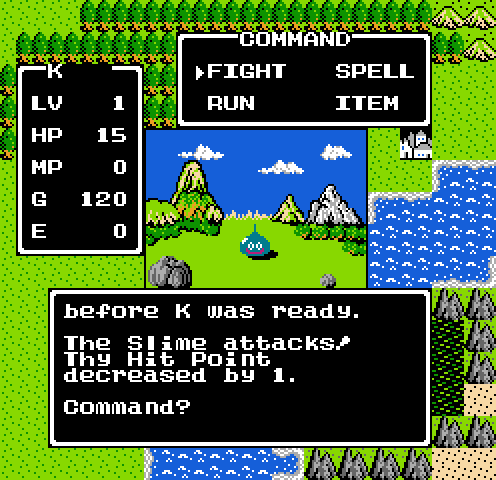 Dragon Quest (1986)
Dragon Quest (1986)
In the first game, the King greets the hero and sends him out onto the heroic deed to save the princess from the dragon that kidnapped her. After that, he might as well also defeat the evil Dracolord. Who funnily enough resides in a castle just across a river from the start of the game, yet as RPG heroes are incapable of crossing any body of water without a bridge or boat, of which the first game has no quest to acquire either, he will have to cross the whole world map to get there.
The first Dragon Quest is a thoroughly basic experience. You get your mission statement at the beginning and then traverse the world to kill evil. All while controlling one character fighting one enemy at once in the random turn based battles. Being strong enough for an area thus is usually very binary depending on the current equip and level of the main and only character. Small world, about a dozen enemy types, mostly grinding filling up the time. Very simplistic, which in the myriad of re-releases that fasten up the pace can have its own kind of charm. It also almost always gets bundled with at least the second game.
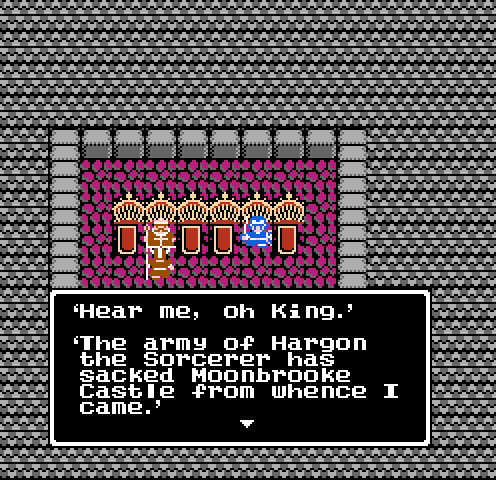 Dragon Quest II: Luminaries of the Legendary Line (1987)
Dragon Quest II: Luminaries of the Legendary Line (1987)
The second game begins with a soldier from a fallen kingdom using his last breath to bring the bad news of the invading evil Hargon to the descendant of the first game’s hero. Who just like his ancestor doesn’t wait long to go out into the world to slay said evil. But this time with some help. Honestly, the story in the second game is still barely more than “this is the evil guy, go defeat him” but with a bit meatier a setup.
Which does also extend to the gameplay. There is just more of everything. The world is a lot bigger, the journey thus a lot longer. We now battle groups of enemies as a party of three people. Who specialise in being mostly a physical fighter, a magician and a useless twat respectively. But for real, the prince of Cannock, who is supposed to be a physical/magical hybrid, dies more often than he’s helpful. There are more enemies, more helpful items, technically more strategy with the bigger party than just “hit it until it dies, maybe heal yourself if necessary” from the first game. It is funnily enough at the same time a lot more than what the first game offered, yet retrospectively still very simple, just taking a lot longer. Which might actually be why it is a bit harder to commit to fully playing through it these days.
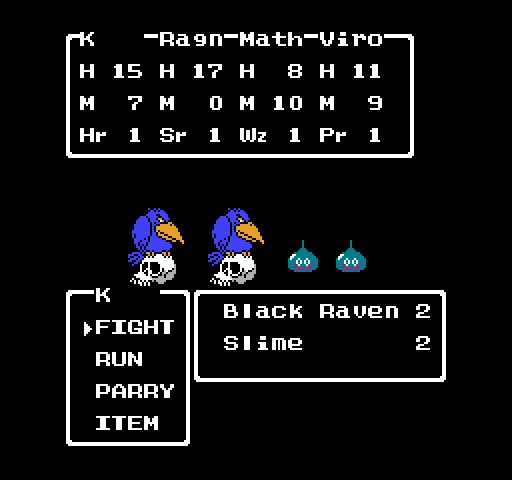 Dragon Quest III: The Seeds of Salvation (1988)
Dragon Quest III: The Seeds of Salvation (1988)
Now we are talking. The main plot of Dragon Quest III still comes down to defeating the evil Barmos who is ruling over the world. But there is a lot more going on now. For example we start with a little cutscene of our father Ortega trying the same and failing, before taking the reels of his son out to finish what his dad started. This is also the first Dragon Quest that really includes a lot of quirky and interesting locations and mini-stories on the journey. A thing the series is more known for than a ground breaking main plotline. It even goes back to the land mass of the first game, revealing to be a prequel all along, which surely was a big twist for an NES RPG.
The basic gameplay, as by Dragon Quest standards, is once again fairly unchanged. Travel around, randomly encounter turn based combats, level up and buy better equip to travel even further and fight even stronger enemies. The team now is four members strong, which should become the default for the games. And here is where Dragon Quest III becomes special. Only the hero character is fixed, the other three in the group can be hired at the guild from one of eight classes. From the strong fighter to the agile thief to the healing cleric or magic flinging wizard. The usual suspects for sure, but it gives the game replay value and tactical customisation this way. This is honestly the first game that does feel like a large yet still classic adventure that’s still worth playing today - at least in the many re-releases that are easier on the grind and the eyes than the NES original.
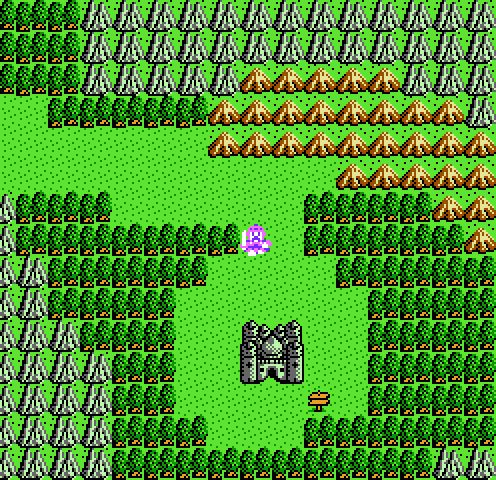 Dragon Quest IV: Chapters of the Chosen (1990)
Dragon Quest IV: Chapters of the Chosen (1990)
The fourth instalment and last one originally released on the NES really hones into the fact that Dragon Quest is usually best in the moment to moment story vignettes on the journey instead of the overall narrative. It bakes this directly into the game’s structure. This time around, one doesn’t even start controlling the hero. Instead the shorter first four chapters are the playable origin stories of the later team members ranging from fighting as a tomboy princess to running the shop of a merchant. They are short nice little insights into those characters before the fifth chapter starts. Which is the main game where one controls the hero with said characters as help through the usual RPG journey. Furthermore, the remakes even add a sixth epilogue chapter, where the team helps out the former antagonist Psaro, fleshing him out beyond simply being evil.
While the gameplay is as traditional as always in theory, one big thing is added. The characters outside of the chapter’s main one are controlled by the CPU. There are different tactics like going all out or concentrating on healing one can chose from, but there’s no direct control by the player for anyone but the hero. At least in the NES original, later releases do give the option to change the control scheme to a direct one for all team members. Still, a remarkable system to include into an 8bit RPG. One that will be in the following games, too.
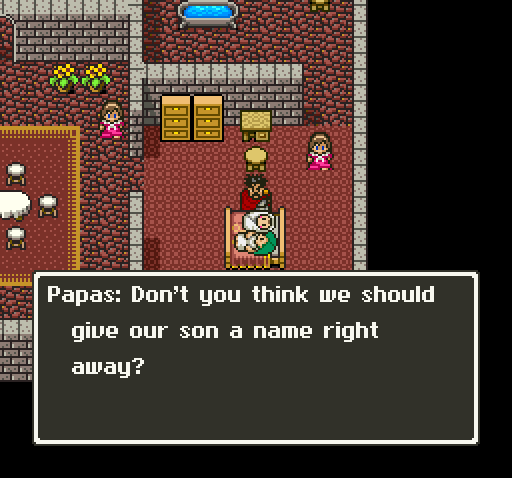 Dragon Quest V: Hand of the Heavenly Bride (1992)
Dragon Quest V: Hand of the Heavenly Bride (1992)
The fifth game, once again, does a special thing for its narration. In here we start at the point when the hero was just a little boy on an adventure with his father. Eventually tragedy strikes and the game time skips to the adult hero now going on his journey to defeat evil in the world. He’ll get married and after another time skip the final party will include his kids. Thus this time the game takes us through large chunks of the hero’s life, making it probably the most emotionally resonating journey of all the games. One actually sees these characters grow over the course of a generation.
One interesting thing in the otherwise fairly traditional gameplay is that Dragon Quest V has a way bigger puzzle part than what came before. You always had to find some progression items like in all RPGs, but this time around there is a higher focus on dungeons having a small puzzles to solve somewhere in there. Another thing is that, due to the story structure, the game tends to change out the available party members all the time. Until the end getting a full human team is very rare. Even more so in the remakes that put the party back to four people compared to the three of the SNES original. Yet the remaining slots don’t need to go unfilled: Dragon Quest V lets you recruit monsters to fight with you. It’s hardly as active as Megami Tensei, since monster decide on their own if they are willing, but it is there. This would later get expanded upon in the Dragon Quest Monsters subseries.
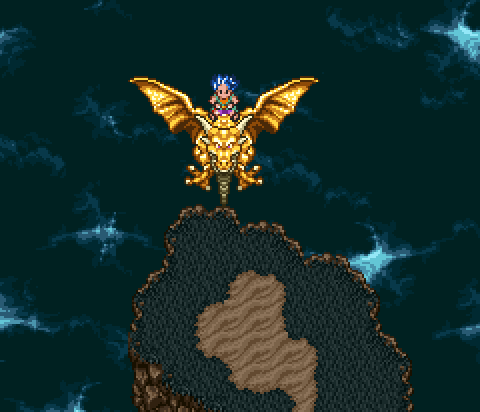 Dragon Quest VI: Realms of Revelation (1995)
Dragon Quest VI: Realms of Revelation (1995)
Dragon Quest VI starts with the group of heroes getting defeated by the bad guy. Or does it? No, it was all just a dream. Or was it? As the hero starts his journey through he lands he starts encountering the people that fought with him in the dream. And will eventually change between the real world and the dream world to stop evil from taking over both of them. With a lot of meandering about in between story beats.
This game brings back the job system. In here it is a more flexible than in the third game, as characters aren’t their roles but distinct people that can easily change and level between many of the classes. There’s even a whole tree of advanced vocations only unlocked after mastering the right prerequisite ones. Other than that this game is mostly known to be the first Dragon Quest to finally look like it comes from a franchise where every entry is a million seller instead of some low budget effort. But honestly, for the most part VI just isn’t that special, especially as the follow up to IV and V.
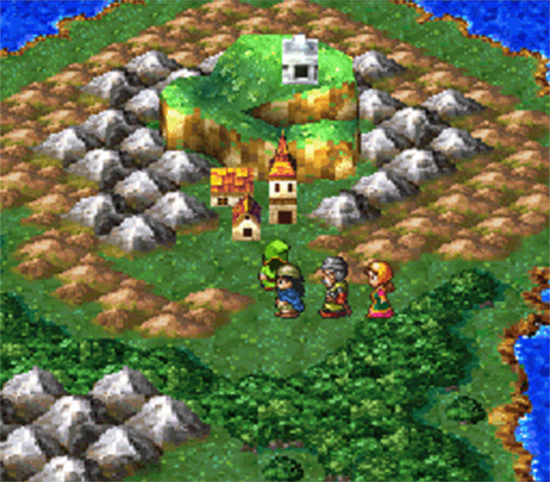 Dragon Quest VII: Fragments of the Forgotten Past (2000)
Dragon Quest VII: Fragments of the Forgotten Past (2000)
The world is very small this time around. Really just a tiny island in the midst of an ocean. At least until the group of friends finds tablet pieces in an ancient ruin. All of them put together summon a new land mass into being. As the heroes start finding out that this world was once filled with life that they now try to uncover anew. The whole game is basically just Dragon Quests insulated vignettes one after another, after another, after another.
Oh man, Enix really made the fans wait on this one. Almost skipping a full console generation even with this late PS1 release. On top of looking like a game that should have come out in the early days of the console, it certainly was put full of content during that long development time. It came on two discs, and for a game that has no voice acting and almost no FMVs, that means it’s really filled with adventure. Dragon Quest VII is actually quite known to have no respect for the player’s personal time. Not unlocking the returning job system until about 20 hours in, finally making the battles more interesting. Play time can reach 100 hours just trying to get to the end and 300 hours if one participates in all the side content. Thankfully the remakes do tighten the pace. But the game still often feels like too much.
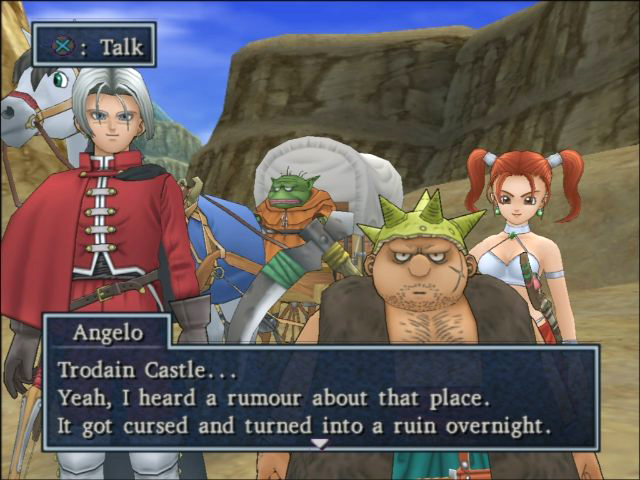 Dragon Quest VIII: Journey of the Cursed King (2004)
Dragon Quest VIII: Journey of the Cursed King (2004)
The court jester is evil. They always are. This particular one uses a powerful staff to dethrone the king by turning him into a troll, the princess into a horse, and putting the whole kingdom behind thorns. Only one guard survives unscathed. Who now goes on a journey with the transformed royalty to find a way to right what was made wrong.
This game is special for many reasons that are not within the game. It was the first game to be called Dragon Quest instead of Dragon Warrior in North America. It is also the first main title to ever be released in Europe. The first title to sell pretty well outside of Japan, too. Since it was the first Dragon Quest for a lot of people, there is a lot of nostalgia involved with it, despite it not doing anything special. Neither the structure of the story nor the gameplay have anything new to offer. They don’t even use a job system this time or more than the four characters of a max party. But it is a charming journey nonetheless, a cozy one if you will. If one doesn’t like very traditional old school RPGing, this series is the wrong one to go for anyways. At least the graphics finally fully advanced to be on par with contemporary games. Thanks to Level 5s expertise in cel-shading, which helps a lot with the game’s charm.
 Dragon Quest IX: Sentinels of the Starry Skies (2009)
Dragon Quest IX: Sentinels of the Starry Skies (2009)
As an angel it is our duty to do good in the world. In exchange for positive energy that will make the world tree grow and bear fruit. The day for this has finally come, yet something is not right. And after losing our wings we are now charged with the journey to recover the lost fruit of the tree that landed all over the world. Like so often in the series, the main plot is mostly there for the beginning and end and otherwise an excuse to get the ball and the little side stories during the journey rolling. With plenty of side quests to take in the tavern for additional play time.
The trusty old Dragon Quest gameplay is back in full force. Going from region to region to ask the townsfolks what problem they need help with. Fighting turn based random encounters on the way to get stronger. Wait, that’s not true anymore at all. While the battle system is the same as always, IX is the first game that shows the monsters roam the world. No more randomly running into them. Otherwise the job system returns once more, but this time in form of the third game. This means that the characters are their classes. They themselves are silent participants during the whole storyline. It also means that job level is character level and thus changing resets one back to 1, though there are benefits that are carried over. Personally I like this less complicated system more than the one in VI and VII.
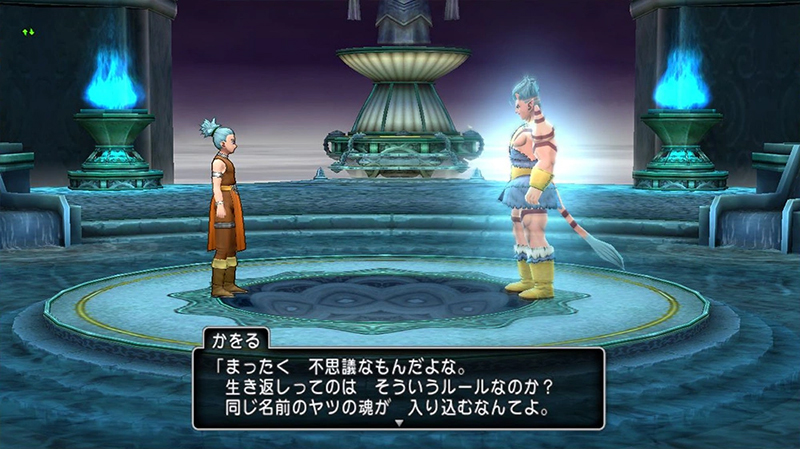 Dragon Quest X: Rise of the Five Tribes (2012 / 2022)
Dragon Quest X: Rise of the Five Tribes (2012 / 2022)
It’s not easy to be the future protagonist of an JRPG. You turn your back to your home village for a second to explore a cave with your friends and what happens? It is burned down by the bad guy. Typical. This time he even seems very successful, killing everyone in the village including the hero. Thankfully a powerful sage rescues our soul by transplanting it into the likewise just deceased body from someone in one of the non-human tribes. In that new form we now have to collect the ten magic emblems to defeat bad guy Nelgel for sure.
Dragon Quest X tends to be quite different to what came before. Mostly thanks to one big thing: It is an MMORPG. And on the Wii which is not known for its great online capabilities, thought by now the still successfully running game obviously made it to every other platform that will run it. The interesting part is that the original hour or two are solo play, only after being turned into the member of a tribe do we start the online multiplayer journey. Through the by now six storyline expansions. The game does its best to stay traditional Dragon Quest though. The battles are real time but let everyone pick from well-known series menus with a waiting timer before the next action. Helpfully, one does not need to rely on other players even, as AI-controlled counterparts can be recruited at the taverns. The game actually offers plenty when it comes to the usual colourful world and charming stories, making it feel very in line with the offline games.
Which it is now too, kind of. For the longest time only the online game existed, making it a no-show in the West obviously. But since 2022 there’s now an additional offline version of Dragon Quest X. Not just the MMO without having to log in, but an actual independent downsized release of the game. Meanwhile he online game is still going and getting new content.
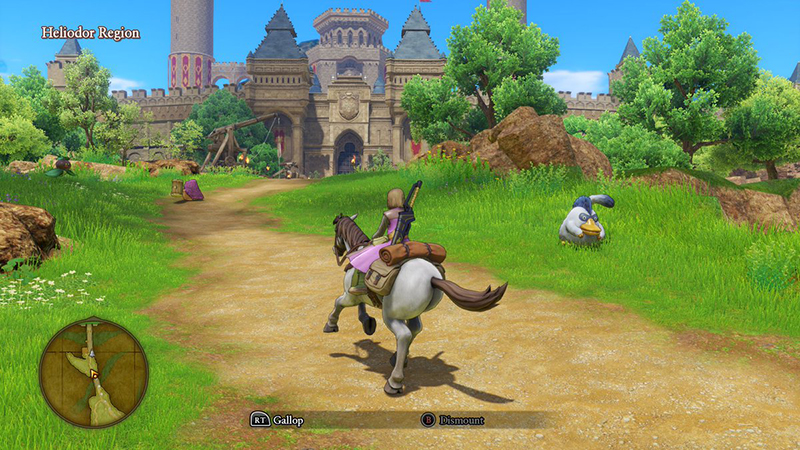 Dragon Quest XI: Echoes of an Elusive Age (2017)
Dragon Quest XI: Echoes of an Elusive Age (2017)
During our coming of age our mother has a revelation for us: We are adopted, a baby found floating down the river after the Dundrasil kingdom was destroyed. To find out our real calling, we are in good old Dragon Quest fashion tasked to an audience with the nearby king. To our surprise he actually throws us into jail, proclaiming the birth mark isn’t a sign of a hero but great evil. Guess we have to break out and travel the world with others that sport the mark of the luminary, while trying to get to the bottom of the legend surrounding it.
Dragon Quest XI was the game made for the 30th anniversary of the franchise. And it shows. During the 70 hours that it takes to finish the game, there will be plenty of little call backs for series veterans. And should one decide to play the additional post game third act, that’s basically all franchise fanservice. The Definitve Edition even lets the player alternatively play in 2D graphics. Dragon Quest is the biggest JRPG hitter in Japan for 30 years and XI is a very confident game because of it. It expects that you’ll like the traditional gameplay, the slower pace, and the charming moment to moment things. Because it knows that several million people will. Thankfully it still uses a lot of smaller quality of life improvements and also looks really great. It’s basically the standard Dragon Quest formula done as well as it gets.
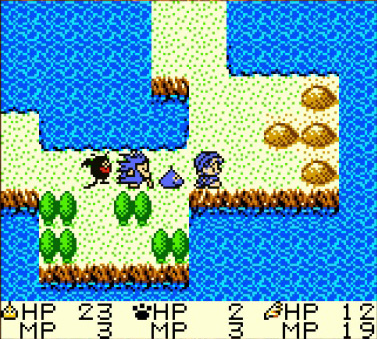
A series that has been selling 3+ million copies ever since the third entry obviously sports a lot of spinoffs and fringe media over the decades. More than needs to be mentioned. Yet we should at least name drop a few RPG or RPG-adjacent ones.
There is for example Dragon Quest Monsters, a take on the Pokemon monster collecting game, but with more of a dungeon exploring take, putting it closer to a traditional RPG but with monsters as team. The series has been going since 1998 and was actually the first Dragon Quest to be released in Europe. Speaking of dungeon crawling, there has also been the Mystery Dungeon series which sports Torneko from DQ4 and Yanugs from DQ8 respectively in Chunsoft’s typical roguelike gameplay. Slime Mori Mori is more of an easy and fun Action Adventure starring the franchises famous slimes as the protagonists. Sadly only one of those was localized as Rocket Slime. Meanwhile one of the newer subseries is Dragon Quest Heroes, which puts series staples into the Dynasty Warriors style of hack and slash. As said, there’s even more, but those are the big ones to mention.